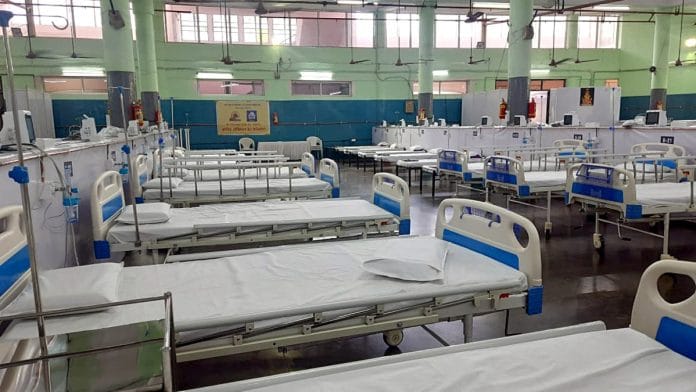New Delhi: As Pune grapples with a rare outbreak of Guillain-Barre Syndrome (GBS), a neurological disease that causes muscle numbness, the Centre has dispatched a multidisciplinary team to the city to take stock and assist the state administration.
Health officials said one person has died and over 110 cases of GBS have been detected in January in and around Pune. More than 15 patients are critical and on ventilator support, as the city struggles to handle the post-infective autoimmune disease that can be life-threatening.
According to the Union health ministry, the multidisciplinary team comprises seven experts from the National Centre for Disease Control (NCDC), the National Institute of Mental Health and Neurosciences, the Regional Office of Health and Family Welfare and the National Institute for Virology (NIV), Pune.
Three experts from NIV had already been supporting local authorities and the expanded team will work closely with the state health department to assess the situation on the ground and recommend necessary public health measures, said the ministry.
A senior NIV scientist, who has been involved in testing samples from GBS patients in Pune, told ThePrint that the norovirus—a pathogen that spreads through contaminated food or water and can cause stomach flu and gastroenteritis—had been detected in several patients.
“Several samples, but not all, had norovirus while in a few samples, the Campylobacter jejuni bacteria that can cause diarrhea was also detected. GBS is most commonly associated with post-infection conditions in patients who have been infected with these common pathogens apart from the Zika virus,” said the scientist who did not wish to be named.
ThePrint reached NIV director Dr Naveen Kumar over the phone for confirmation but had not received a response by the time of publication. This report will be updated if and when a response is received.
During a press conference Tuesday, Indian Council of Medical Research (ICMR) director general Dr Rajeev Behl said so far 24 stool samples from GBS patients had been examined of which four had shown the presence of Campylobacter Jejuni—but not the others.
“GBS usually occurs in people 4-6 weeks after episodes of infections and we are trying to understand the history of infection in the affected localities over the last several weeks,” he said.
Behl also said the common link established in all GBS patients so far is diarrhea, which indicates a history of stomach infection.
“However, we are yet to fully understand the nature of infection and the pathogen behind it and why it has led to a big cluster of GBS cases in a certain region,” he added.
Also Read: Guillain-Barré Syndrome outbreak in Pune: What you need to know about this rare nerve disorder
What is GBS and what triggers it
GBS is a rare disorder in which a person’s immune system attacks the peripheral nerves and people of all ages can be affected, but it is more common in adults and males. The syndrome is named after French neurologists Georges Guillain and Jean-Alexandre Barre who, along with physician Andre Strohl, described the condition for the first time in 1916.
It is a consequence of either a gastrointestinal or respiratory infection where antibodies produced by the body’s immune system to fight the infection cross-react with the nerves due to molecular mimicry (when pathogens mimic the body’s own proteins), causing progressive weakness of limbs, explained Dr Manish Chhabria, neurologist with Sir H.N. Reliance Foundation Hospital. In a few cases, it can also occur post-vaccination.
Most people recover fully from even the most severe cases, which are rare but can sometimes result in near-total paralysis and breathing problems.
Also, as the condition is potentially life-threatening, those affected should be treated and monitored as quickly as possible and some may need intensive care.
The first symptoms of GBS often include weakness or tingling sensations, often starting in the legs and sometimes spreading to the arms and face.
For some patients though, the symptoms can lead to paralysis of the legs, arms or face muscles. In some cases, the chest muscles are also affected, making it hard to breathe.
In severe cases, the ability to speak and swallow may be affected, requiring intensive-care treatment.
Also, even with the best medical care, a small number of Guillain-Barré syndrome patients die from complications such as paralysis of the muscles that control breathing, blood infection, lung clots or cardiac arrest.
Treatment normally includes supportive care and some immunological therapies.
Why the outbreak
Doctors don’t have any definitive answers on the trigger yet.
Dr Prajwal Rao, professor and head of the department of neurology at Pune’s D.Y. Patil Medical College, Hospital and Research Centre, told ThePrint that GBS typically occurs as isolated cases, often triggered by an infection, and major outbreaks are rare.
During the Zika virus epidemic in French Polynesia in 2013-2014, a significant increase in GBS cases was documented.
Similar outbreaks were reported in Peru in 2019 and 2023, with Campylobacter jejuni identified as the most common infection linked to these cases, Dr Rao said.
Senior epidemiologist Dr Amitav Banerjee, formerly associated with the Armed Force Medical College (AFMC) in Pune, emphasised that the clustering of GBS within a short time and across a few sites in the city “does not make epidemiological sense as the background rate of the condition is 1 in 100,000 persons per year”.
“While Campylobacter jejuni has been known to cause GBS, why a surge now since the bacteria has been with us for ages is something we need to understand,” he said.
Dr Banerjee also stressed that authorities should examine the possibilities of chemical poisoning since mercury and arsenic can pollute water bodies and and lead to GBS-like symptoms.
“As of now, it may appear a bit far-fetched but we should explore all possibilities,” he said.
This is an updated version of the report
(Edited by Sugita Katyal)
Also Read: In Jammu’s Budhal, fear grips villagers in wake of 17 ‘mysterious deaths’ in 45 days






